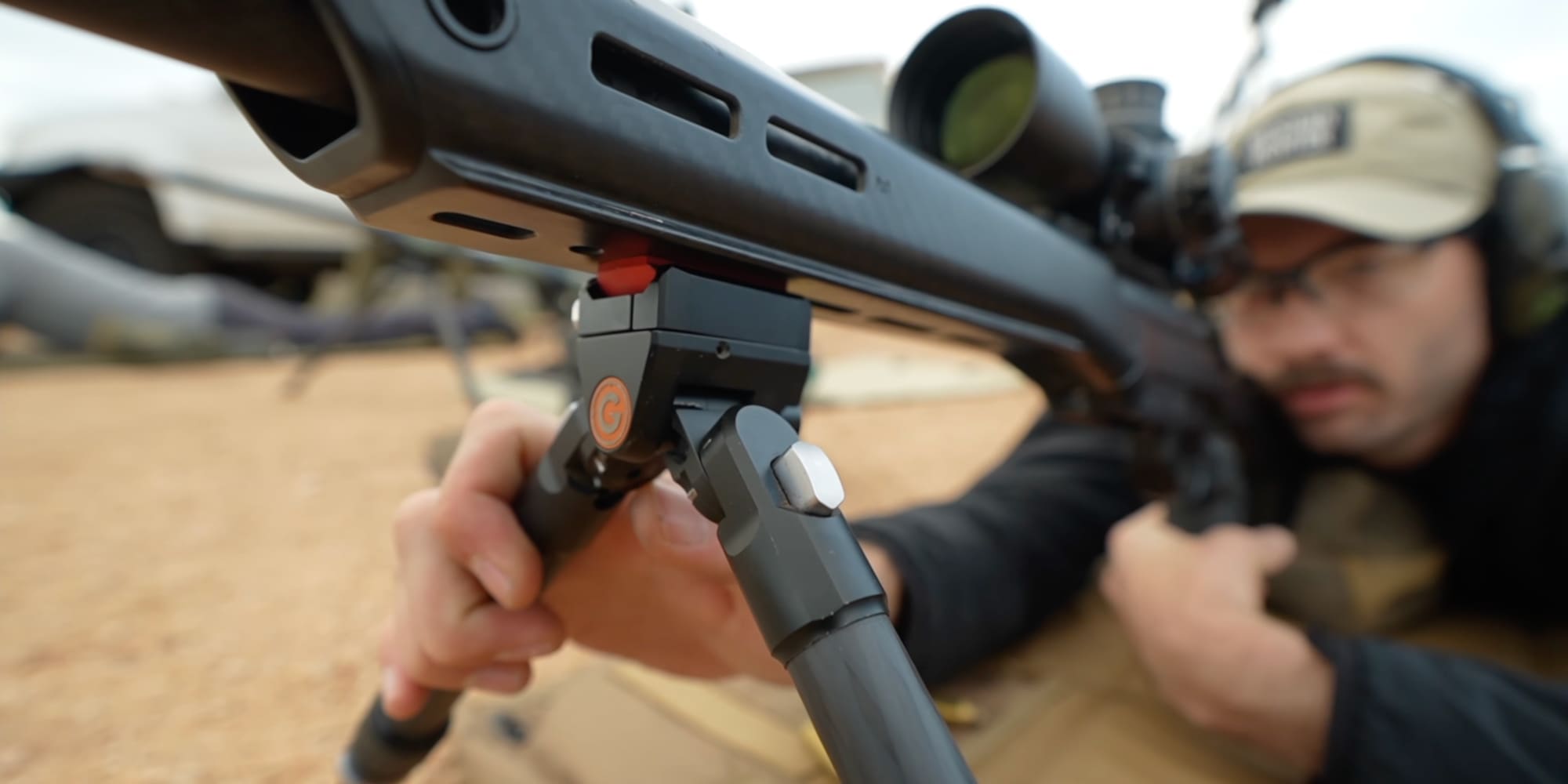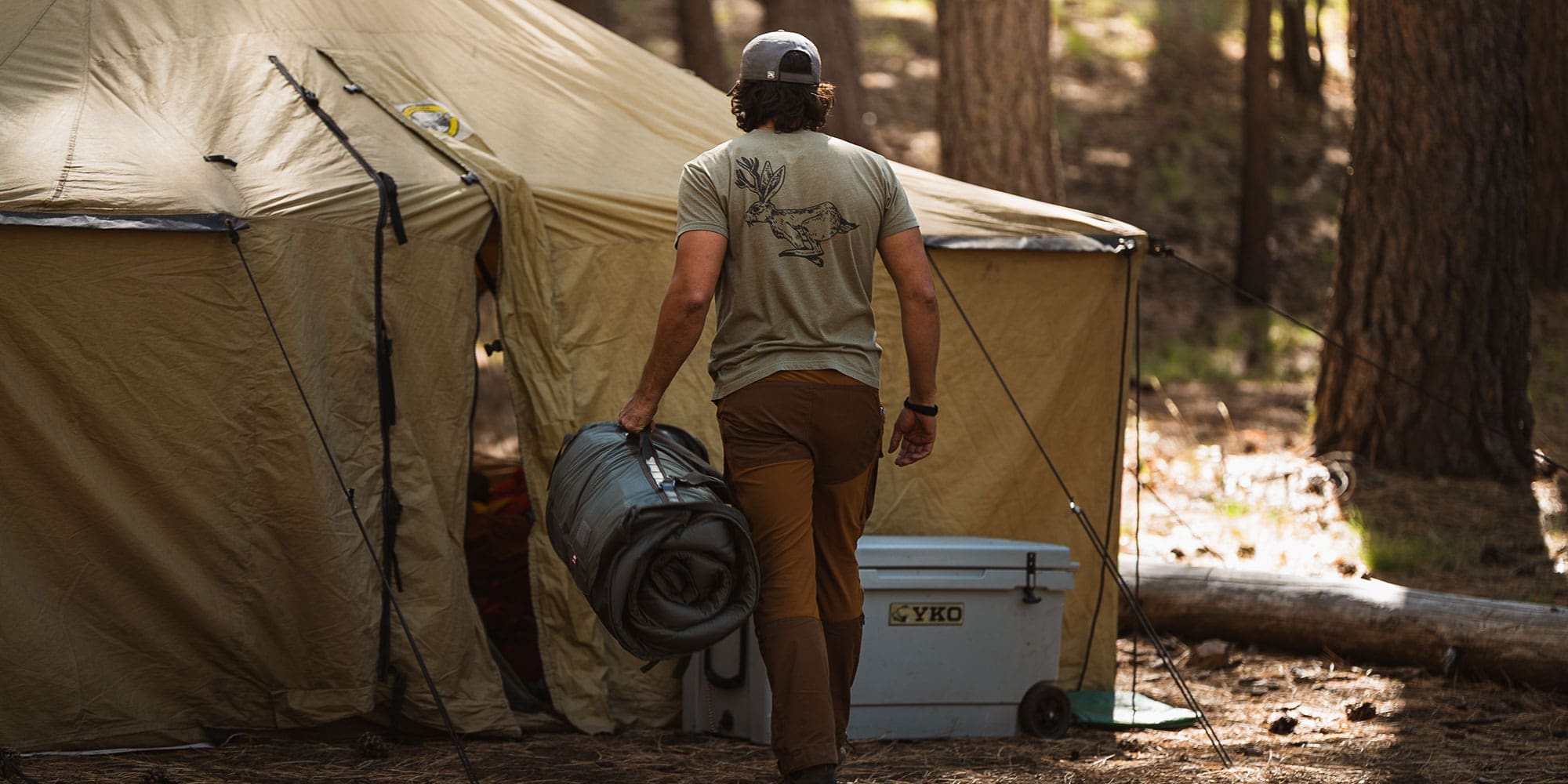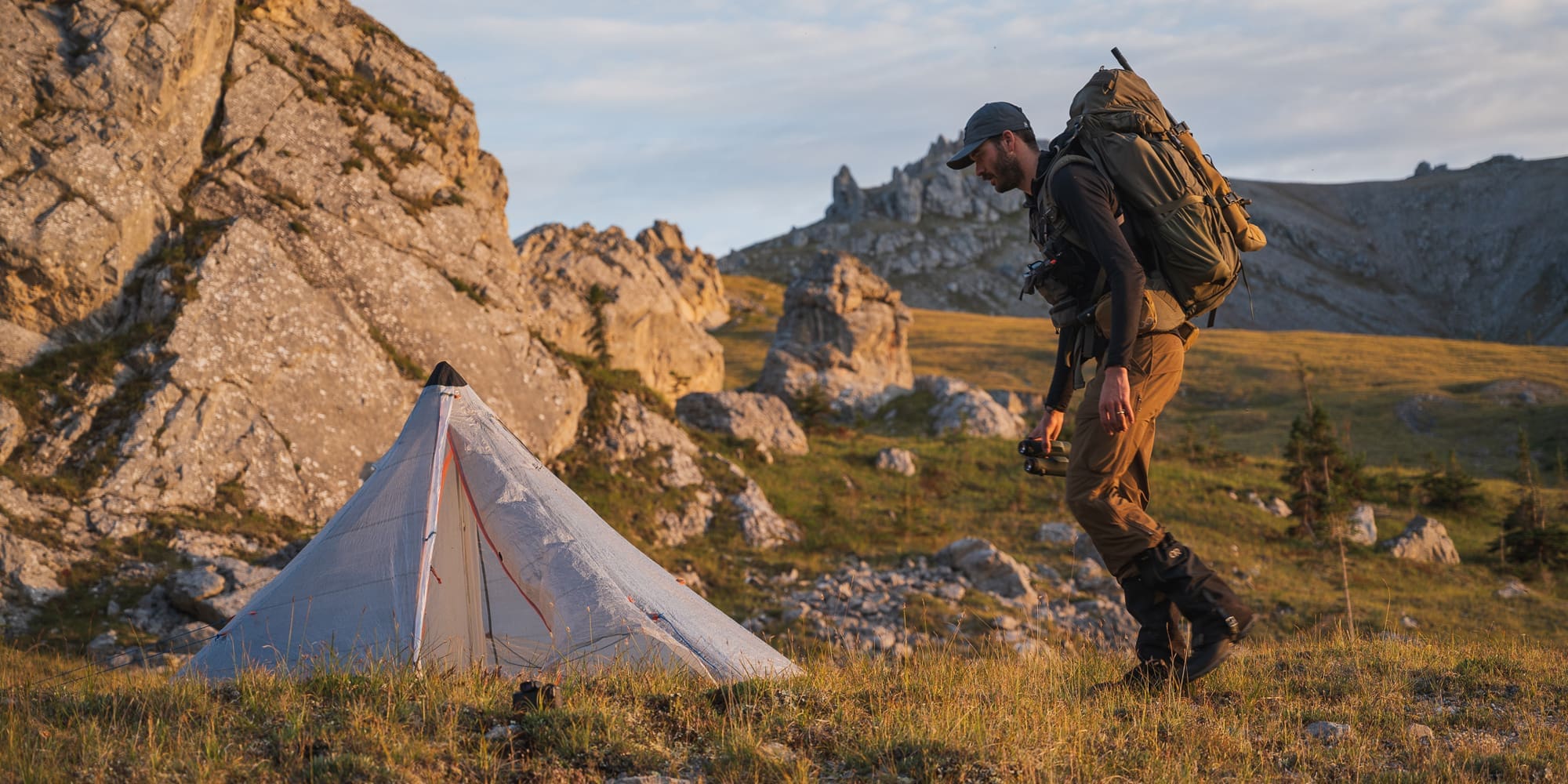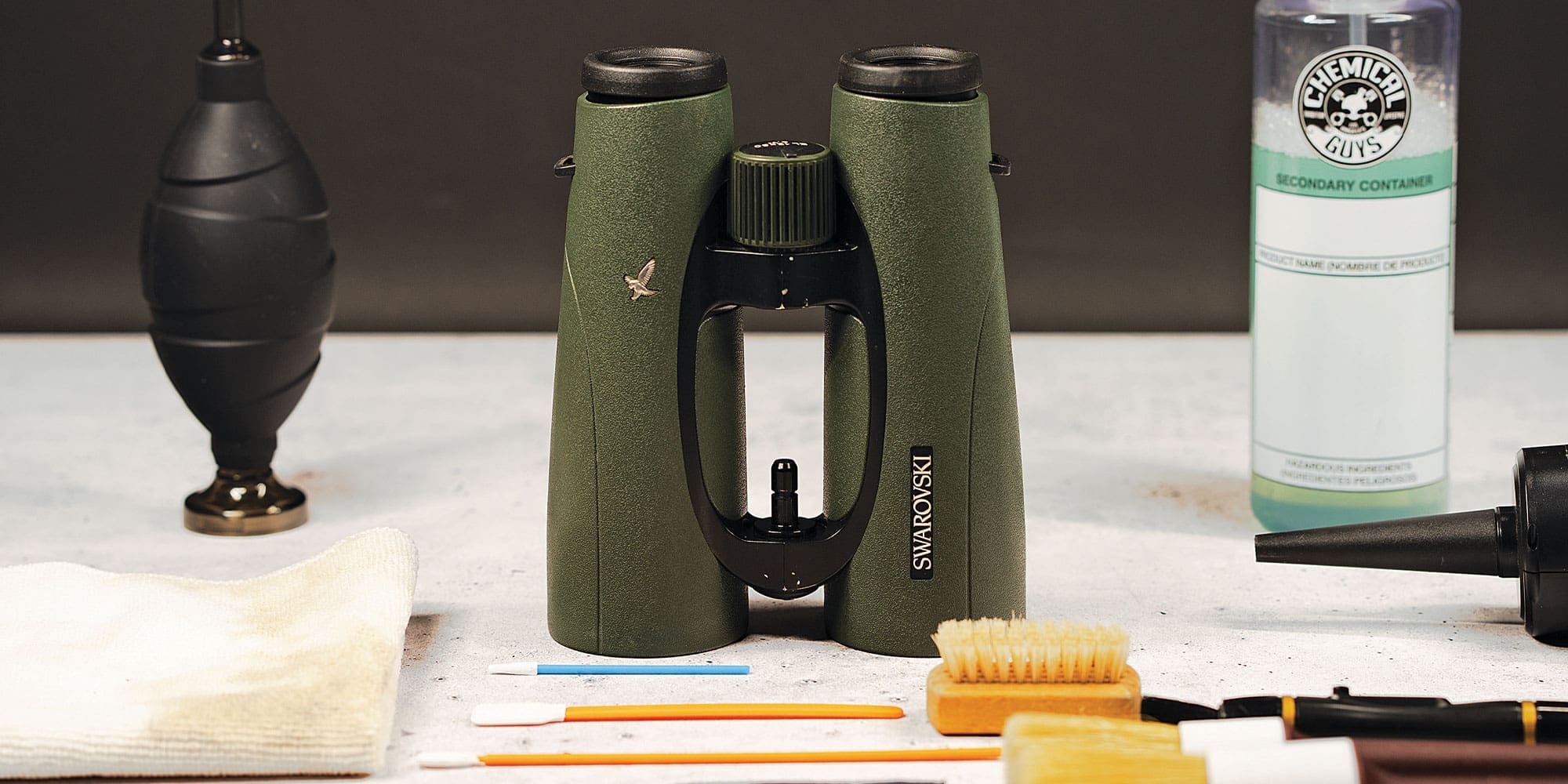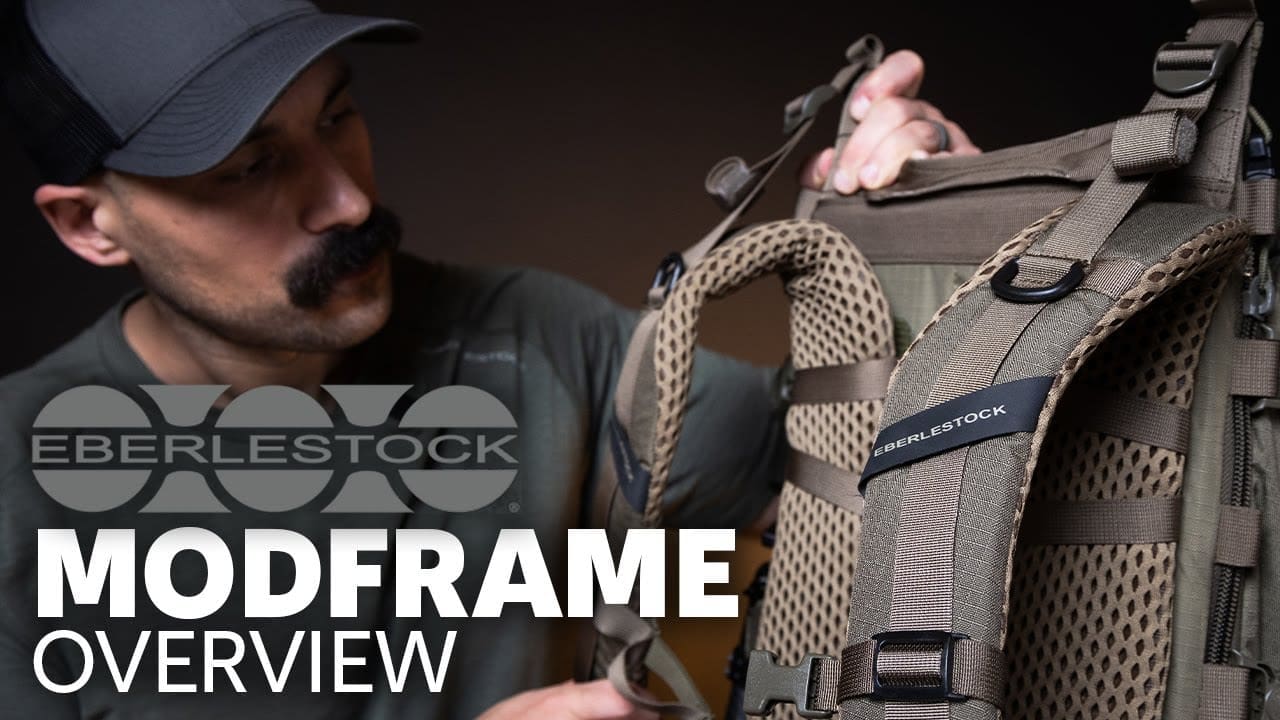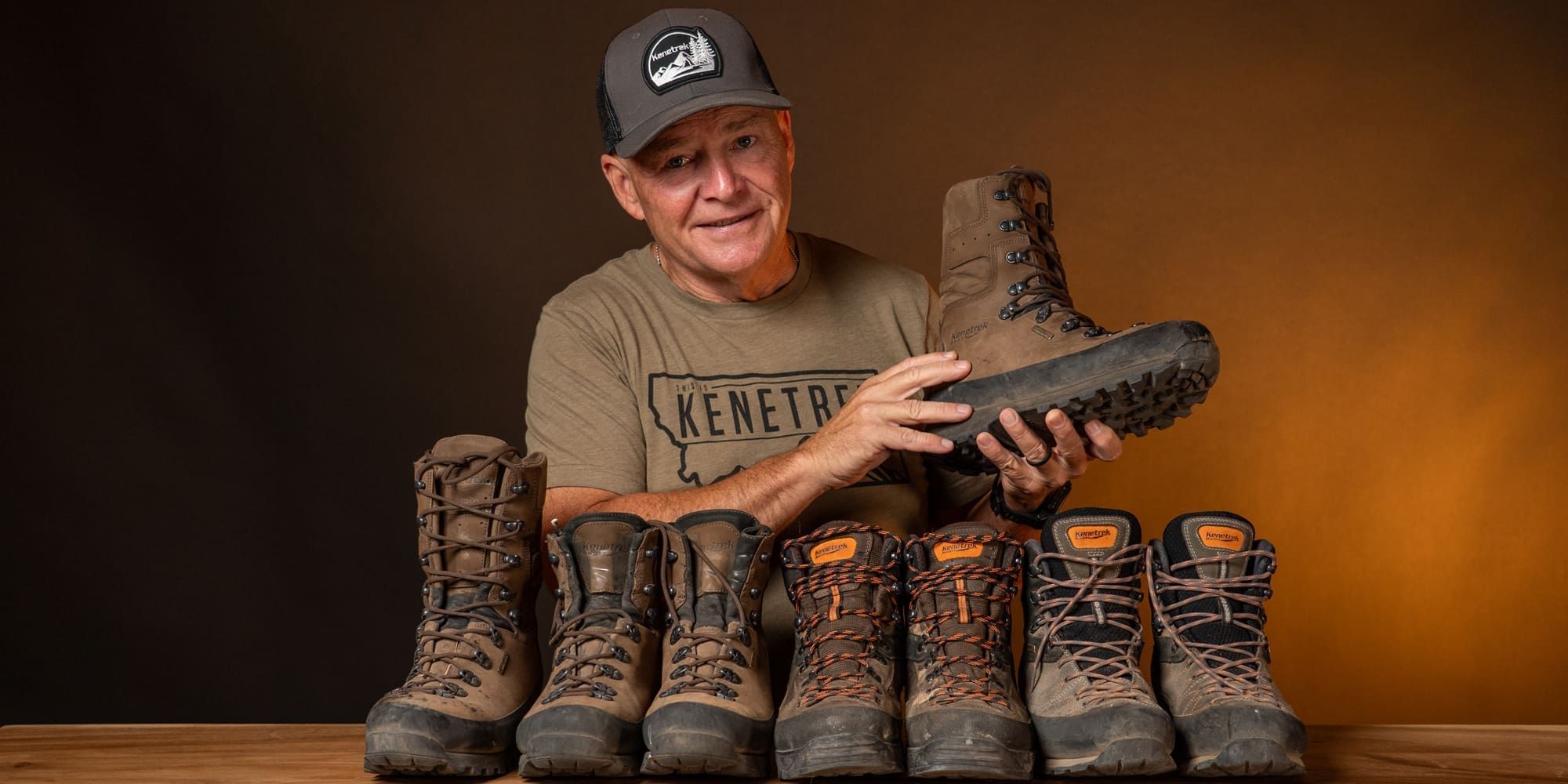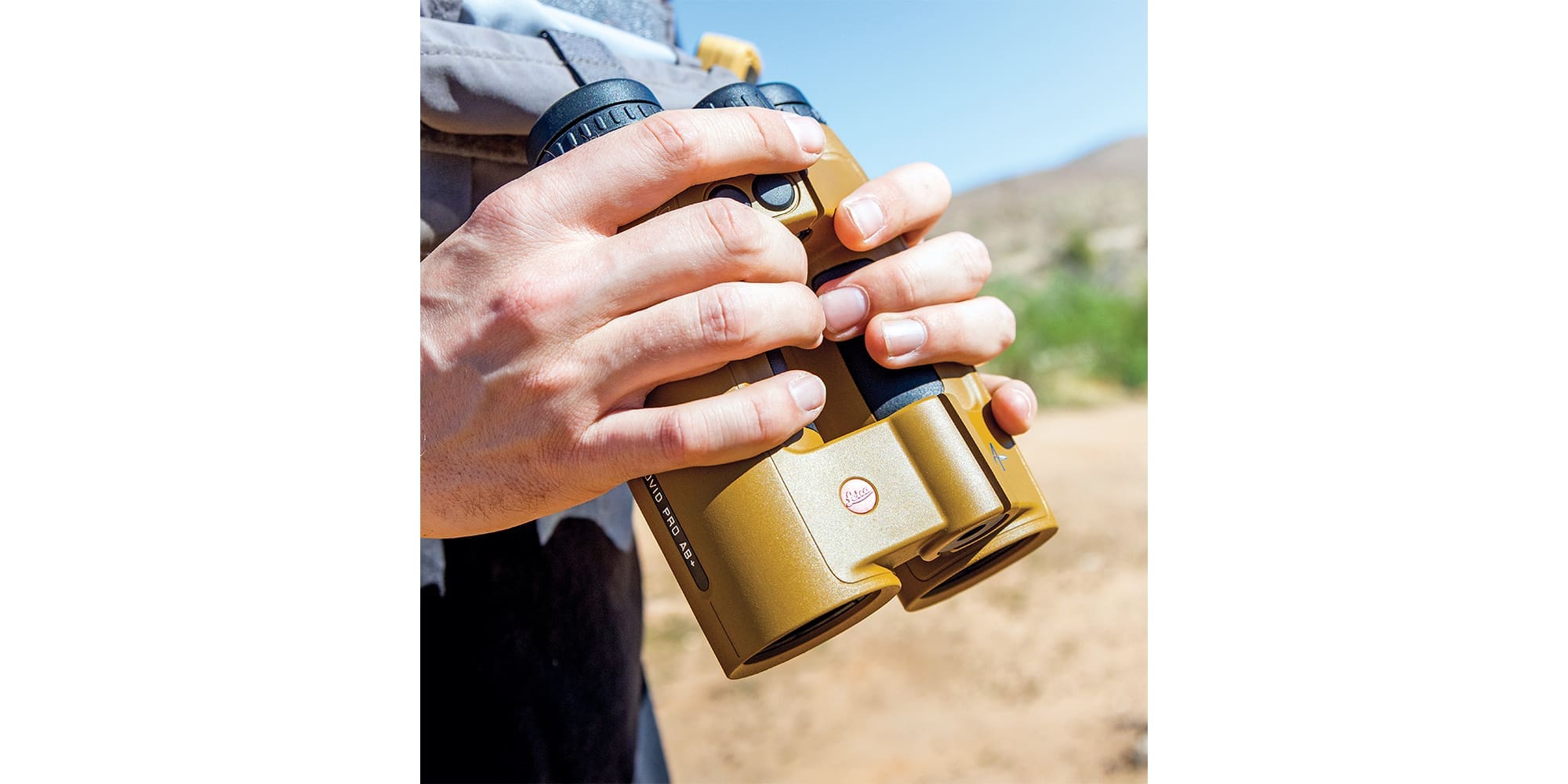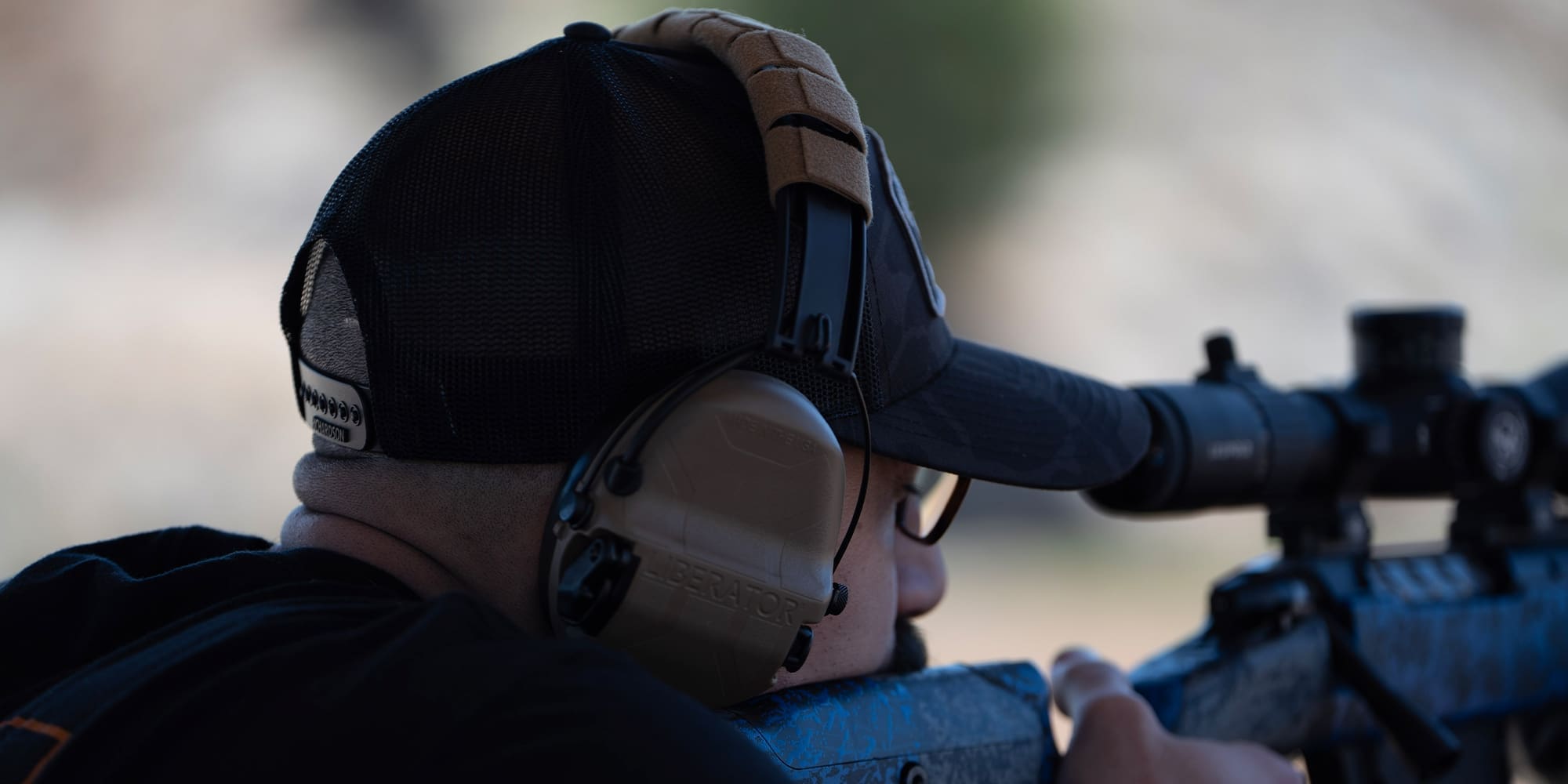
NOTICE: Certain links on this post may earn a commission for Western Hunter Magazine from Amazon or our other affiliate partners when you make a purchase. Thank you for your support.
Mobile Horseback Hunting Camps
Flexibility is often the key to being successful horseback hunting.
Colorado wilderness areas, with their unique topography and abundance of mule deer and elk, provide interesting opportunities for horsemen to use mobile roving camps to access a wide range of habitat types and elevations.
When we think of backcountry elk camps, the picture that most often comes to mind includes wall tents with lodgepole frames, woodstoves, stacks of seasoned firewood, and lots of good food for hunters and livestock - a supply of everything required for a significant stay in the backcountry. Typically, these camps are located in areas familiar to the hunters and provide strategic access to elk either via horseback hunting or on foot.
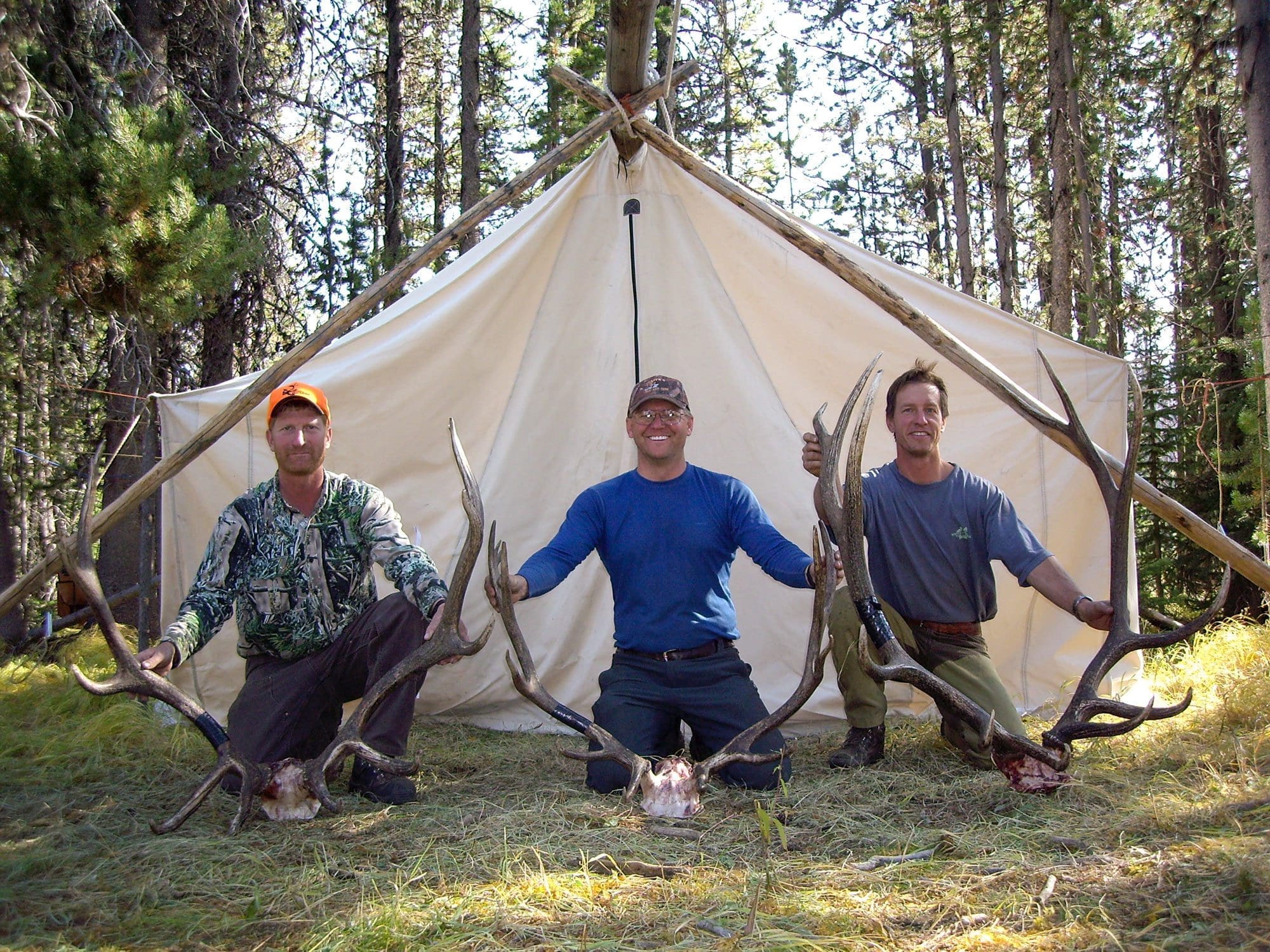
When we think of traditional backcountry elk camps, we usually think of big bulls and camps with wall tents, lodgepole tent frames, woodstoves, stacks of firewood, and lots of good food for hunters and livestock.
I’ve used camps like this for years throughout the western U.S. for horseback hunting elk, mule deer, mountain goat, bighorn sheep, and black bear. These camps provide everything a hunter needs for access to big game, a good night’s rest for hunters and livestock, and sustenance to keep hunters and livestock fit for each new day of hunting.
A Need to Adapt
While using these camps, I’ve also encountered the need to have all of the necessary essentials and be extremely mobile in situations where the game and country require such. Having the “right stuff” and being able to make the best of every horseback hunting situation makes a huge difference in the success of any backcountry hunt.
This fall three friends, Todd Huck, his son Derek, Jacob Olmstead, and I had a great opportunity to apply the techniques and gear required for horseback hunting on a trek to Colorado for mule deer and elk. We planned for the camp to be mobile from the start; thus we selected lightweight gear that would weather everything from moderate weather to deep snow and cold. We also wanted to have a comfortable camp in the event of snow and cold weather at elevations between 10,000 and 12,000 feet, deep in the wilderness.
We hauled five horses and my mule to Colorado from Washington and Montana. In order to be “self-contained” and hunt the full nine days of the second rifle season, we chose to use five pack animals. As the senior citizen in the party, I got to ride my mule, Hydro. Todd, Derek, and Jacob hiked in with their backpacks.
One challenge that became apparent as soon as we got on the trail was the fact that the cattle which graze the area each summer under Forest Service grazing allotments had literally eaten every blade of grass to be found, anywhere. Upwards of 1,300 cow/calf pairs had ranged up as high as 11,000’ in elevation, and with the drought conditions of the past year or so, there was literally no grass for our stock.
In the past, by moving high lines or using a portable electric fence, we had at least found some grass for our stock, but this year the ground was bare everywhere. The compressed weed-free bales and alfalfa cubes would have to be used sparingly in hopes that it would last the duration of our trek.
We had hunted this country in the past and knew we’d be spending a lot of time glassing from high points at long range for quality mule deer bucks as well as elk. We wanted our camp and gear to be mobile in order to enable us to hunt a broad swath of country over the course of the nine-day season. Our primary quarry was mule deer bucks, with bull elk being secondary.
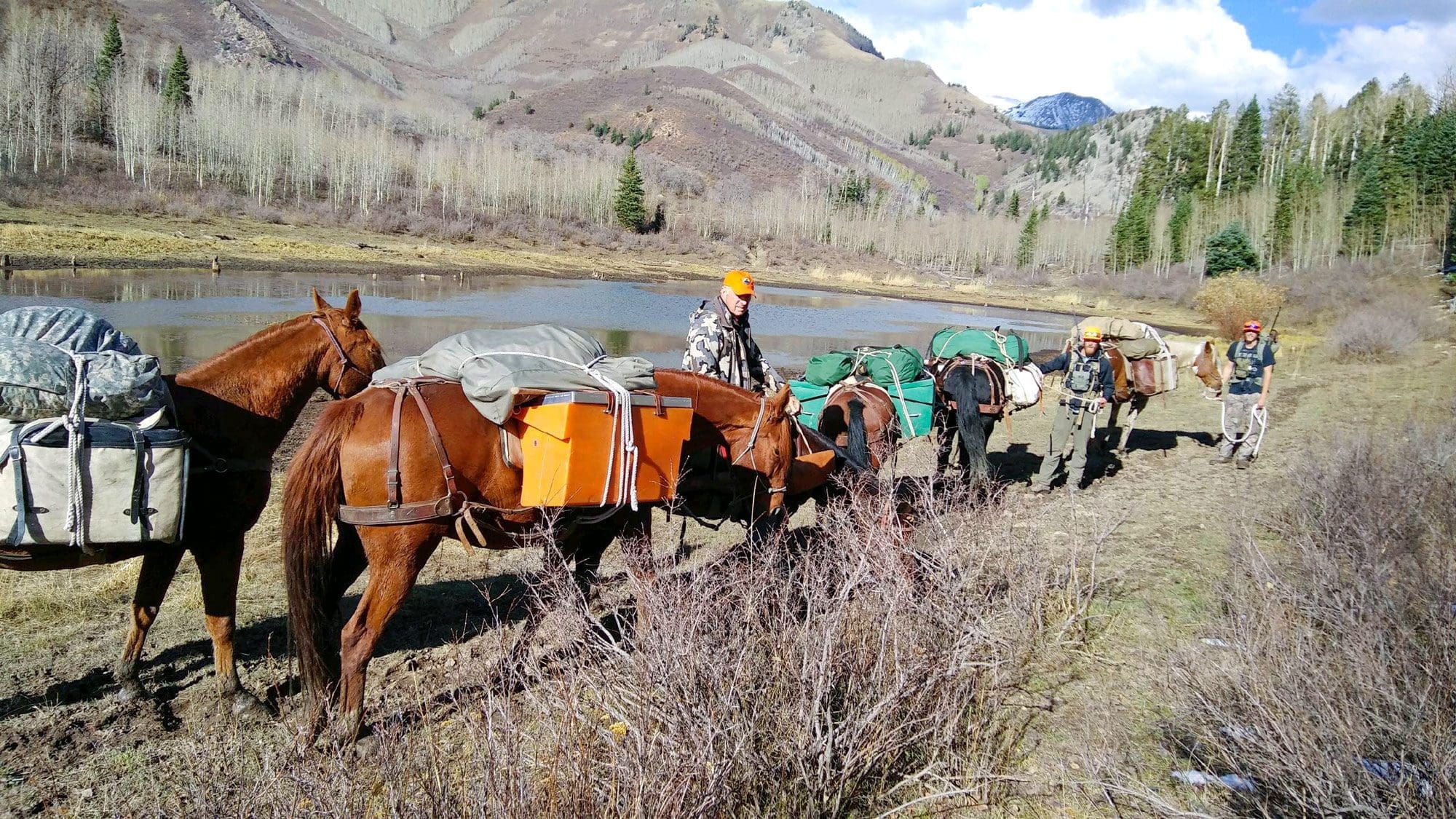
We hauled six head of stock to Colorado from Washington and Montana. In order to be mobile, “self-contained” and hunt the full nine days of the second rifle season, we chose to lead five pack animals. As the senior citizen in the party, I got to ride my mule, Hydro.
In this area, we’ve found that the mule deer are usually still located on the high ridges and tops of the mountains during the second rifle season and tend to be in the same habitats year after year. We’ve also learned that while spotting for bucks, we’ll find bull elk in similar habitats.
In this country, the mule deer may not move a great deal from day to day, but bull elk will travel long distances and pop up just about anywhere, especially after being bumped by hunters.
We arrived in Colorado knowing that this year might be different, as there had been a significant snowfall in the backcountry the week before we arrived. Not knowing how the early snow would impact deer and elk movement, we employed our “normal” strategy to spend a night and morning glassing from a high point halfway to our primary destination. If we were able to spot a good buck, two of us would stay and stalk it while and the other two would go on to the second campsite where we hoped to find both mule deer and elk.
The first night and morning of glassing turned up very few bucks and no elk within stalking distance, so we moved on to our second campsite deeper into the wilderness. The snow had melted at the lower elevations of the mountain range we were horseback hunting, but it was at least two feet deep at the elevations where we had found good bucks in the past.
Our glassing point was ideal, offering a 360-degree view. While glassing on the first morning, a herd of elk showed up on a ridge more than a mile away in the opposite direction from our camp and primary area of focus. They had been bumped by hunters and were moving in our direction.
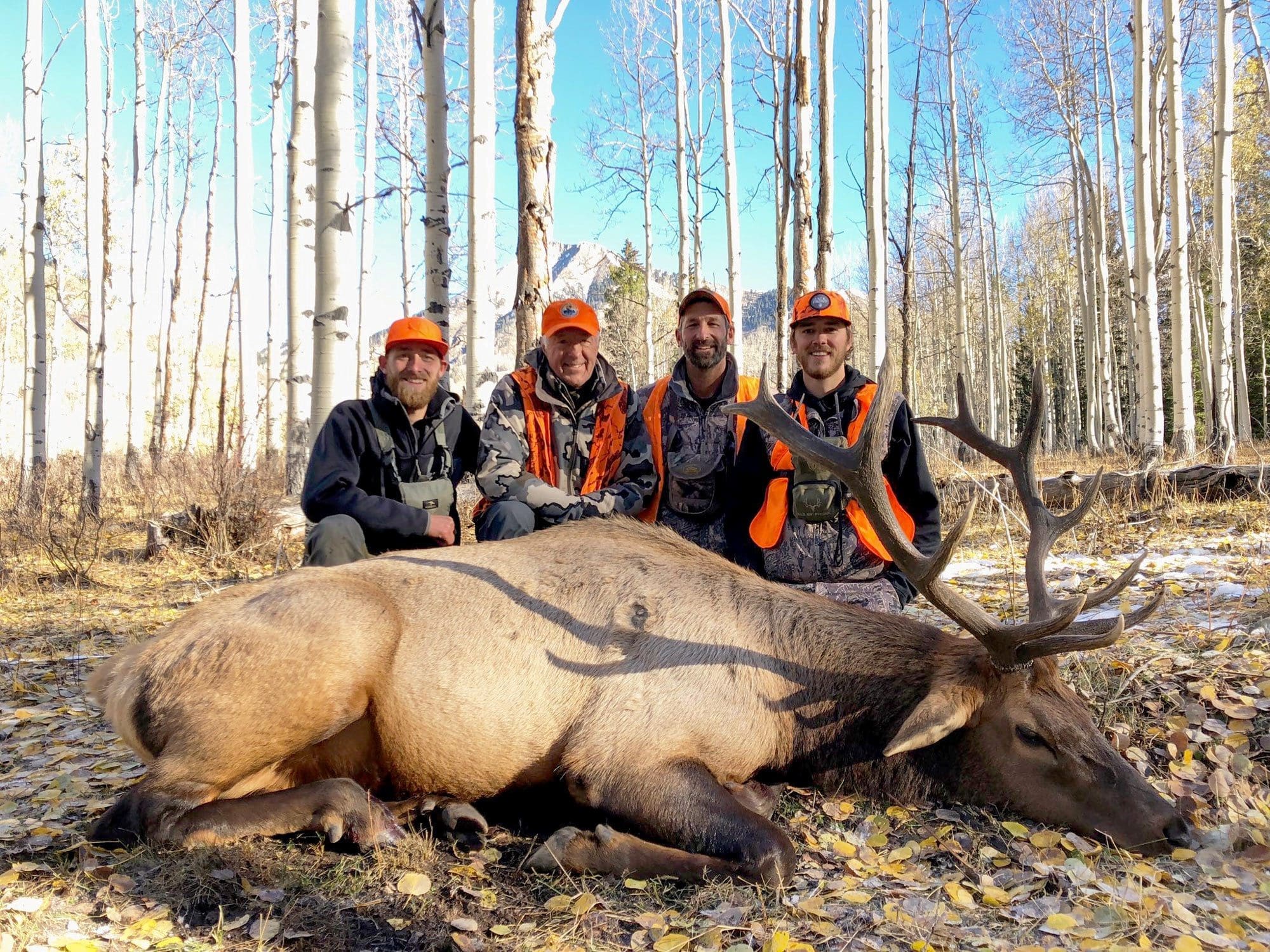
Jacob Olmstead got his Colorado six-point the first day of our hunt by intercepting a herd of elk that had been bumped off a ridge a mile away. Derek Huck, the author, Todd Huck, and Jacob Olmstead celebrate Jacob’s bull.
After an evening and two mornings of glassing in earnest from camp #2, we decided that we were horseback hunting an “elk-free zone” and the bucks had left as well. Tracks in the snow at higher elevations were nonexistent, so we speculated that the bucks had drifted down into the aspen thickets, making them nearly impossible to see, evaluate, and hunt. We weren’t sure just where the elk had gone, as Jacob’s bull had come from a completely different drainage.
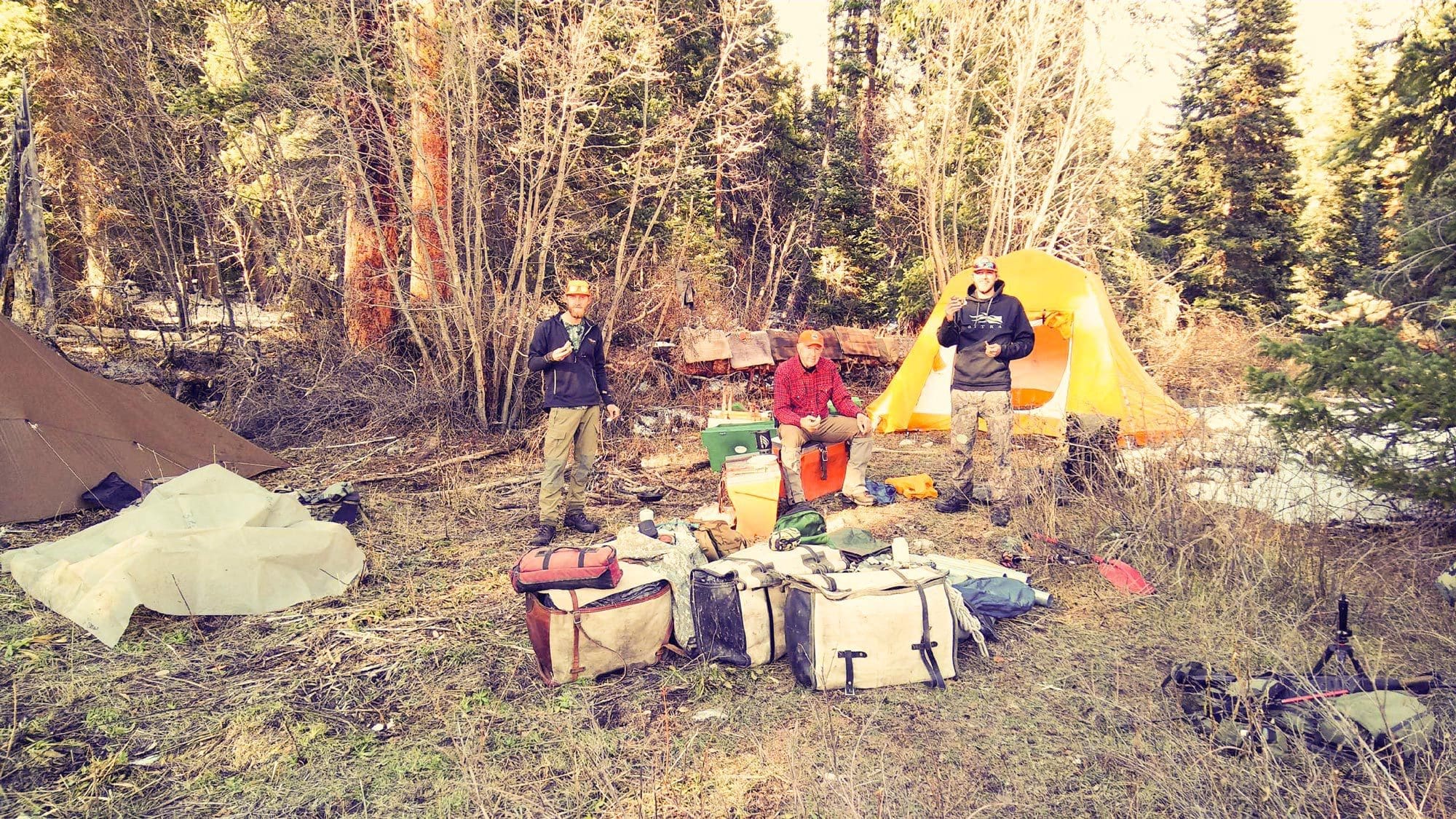
Derek and Jacob take a lunch break with the author at Camp #2 on a small flat in the bottom of the valley with just enough room for our tents and a place to high-line our stock in the timber behind camp.
It was time to move to camp #3 that afternoon. With four of us working together, we had it taken down, packed, and loaded on the stock in two hours, leaving room to pick up and take Jacob’s bull with us on the way to camp #3.
Camp #3 turned up more game. It provided three excellent glassing points from which we saw multiple bucks, cow elk, and one 5x5 bull. One buck looked promising, but after a stalk up the mountain to within 300 yards, we decided he wasn’t big enough yet.
Although we could have stalked the elk, we wanted to move to camp #4 because we could see some nice bucks on the back side of the ridge we could glass and hunt from camp #4. Camp #4 was also a better place to find a bull elk or two, we moved again.

Camp #4 was located on a small bench/opening in the aspens on the valley floor. A spring bubbled out of the ground just 20 yards from camp. A short climb got us to a glassing point, from which we could see a couple miles in a 180- degree arc. Cattle use here wasn’t as harsh, so we were able to stretch our horse feed to the last day of the hunt.
Camp #4 offered a glassing point from which we had a 180-degree view of a huge basin. This was to be our final stop before season’s end. We were seeing good bucks in all directions, as each day different bucks would appear.
After sorting through more than 30 bucks, Derek found one he liked. The stalk took him and Jacob just an hour and a half. They wore smiles on their faces when they arrived at camp near dark with backpacks full of antlers, cape, and boned-out meat. It was a great 180-class buck.
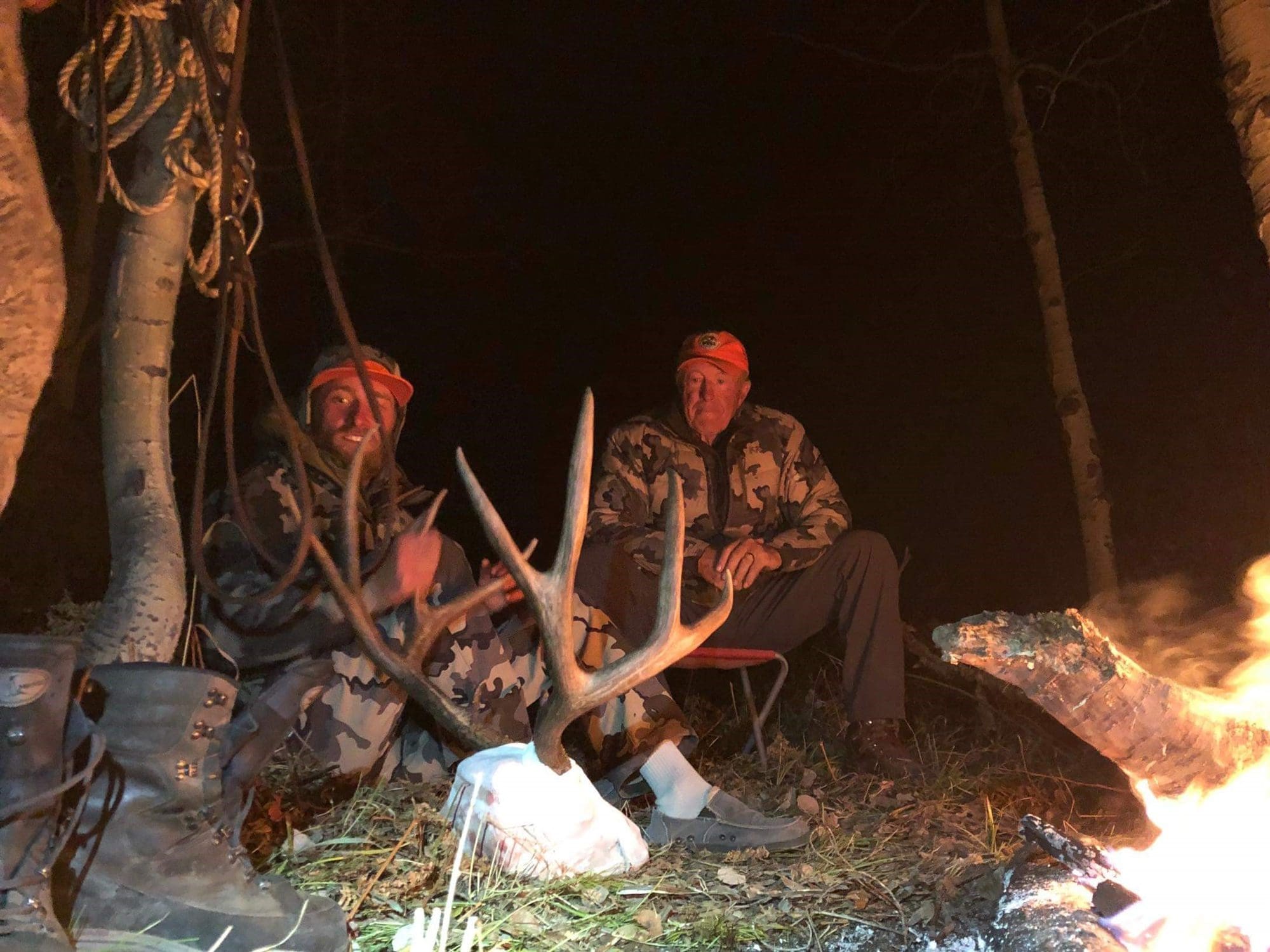
Derek Huck reflects upon the day’s hunt with the author.
Although we had seen several bull elk while glassing for Derek’s buck, all of them were either too distant to stalk or on the move. On the last morning of the hunt, Todd spotted a 6x6 bull that he liked. It was nearly a mile distant, but he commenced the stalk. Jacob went along with him and in less than an hour, the bull was down.
Once the bull was down, Derek went up the mountain to assist with backpacking the bull to camp. The location of the bull and the time required to get the stock to the bull made it more efficient to bone out the bull and backpack it to Camp #4.
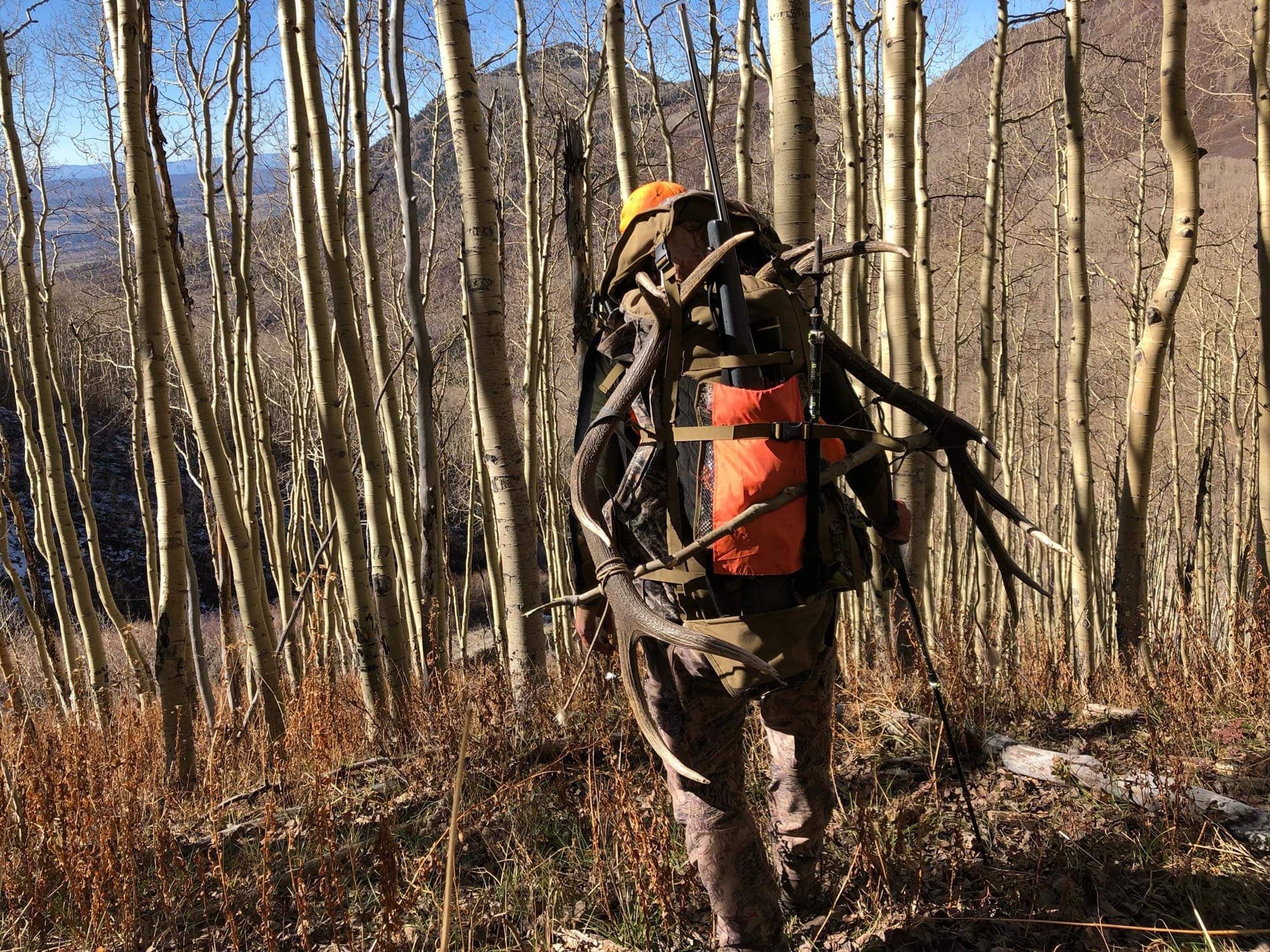
Considering the time of day and the fact that we needed to pack out of the area that evening, it was more efficient to bone out and backpack Todd’s bull to Camp #4.
As the afternoon sun began going behind the mountain, we had all of our camp and meat packed and loaded for the trip out. We didn’t fill all the tags we had, but we filled the ones that we chose to fill.
Techniques and Gear
As I rode Hydro down the trail with Todd and “the boys” leading their stock ahead of me, it was a good time to reflect on our trip and the techniques we used on the hunt.
Horseback Hunting Techniques:
Our horseback hunting technique involved spotting mule deer bucks at distances of up to two miles, looking for bucks that would score 180+/- B&C, which was our criteria. We have hunted and measured mule deer over decades of hunting and with the aid of high-quality optics, our evaluations are solid. Even so, a stalk to within 300-400 yards will facilitate a better estimate.
Once we spot the buck we want, the stalk could involve up to a couple hours to get into shooting position for a “same-day” kill or perhaps an overnight bivy on the mountain required for an early-morning shot. This required camping in strategic locations we might not select for a wall tent camp. Our gear had to be such that we could “bunch” and move camp in an hour or two at the most multiple times over the course of a nine-day hunt.
Camp Gear:
Lightweight horse packing gear, camp gear, and high-tech clothing have changed a great deal in the past decade. Today, there are some excellent options to the traditional backcountry “horse” camp. Backpack camps, as well as spike camps with livestock, reflect these changes with hunters and their stock being more and more mobile and much less dependent upon camp fixtures common in a stationary camp.
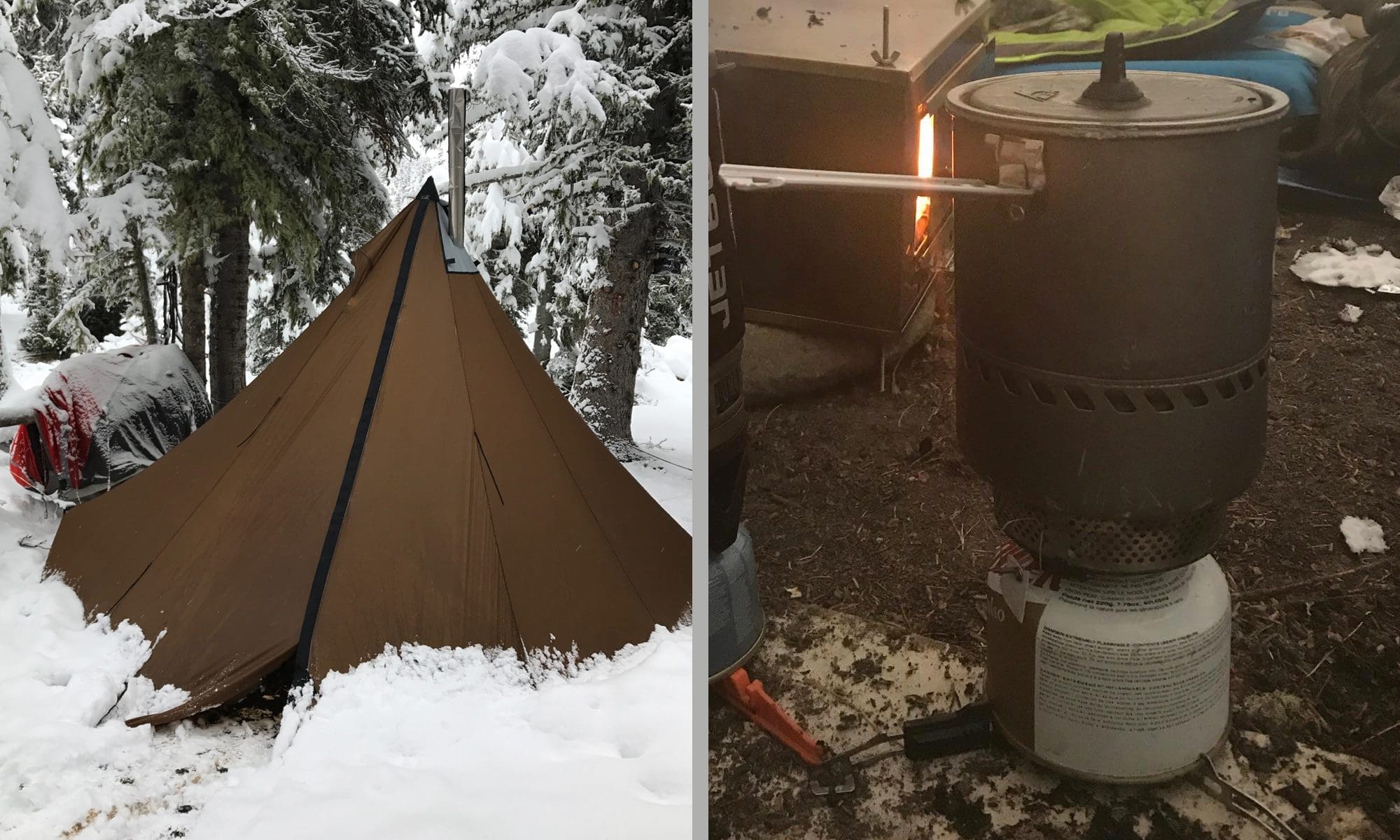
A quality ultralight shelter, such as this Sleep Outside Tipi equipped with a Sleep Outside packable titanium woodstove, can “save the day” when hunters experience deep, wet snow in the backcountry.
For tents, we chose two of our personal tents that we’ve used for a number of years. One was a Kifaru Sawtooth, which Derek Huck and Jacob Olmstead slept in. The other was an Arctic Oven 10’ extreme, which Todd Huck and I used.
Both were outfitted to accommodate a stove. Derek and Jacob used a Kifaru box stove in which Jacob made a fire each morning and they were pretty cheery about it. . . at least until they forgot their four “redi-rods” and wing nuts at Camp #3, essential items for assembling the box stove.
When I asked Todd about Derek and Jacob staying on the mountain after a long late-evening stalk, he replied, “They can make a fire like they’ve done in this country in the past!”
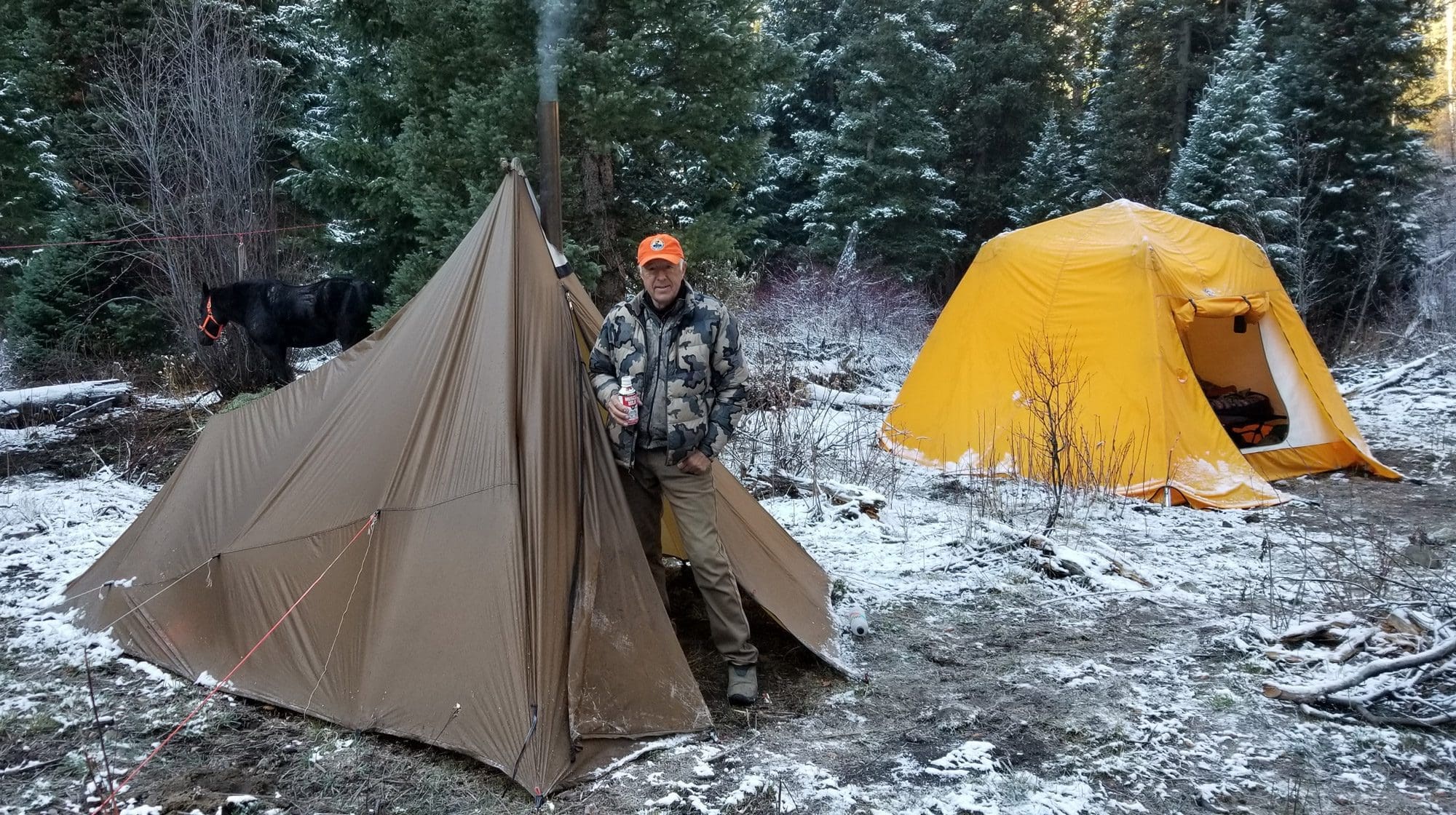
The Arctic Oven 10' Extreme made by Alaska Tent and Tarp (R) and the Kifaru Sawtooth (L) with the Kifaru collapsible box stove proved to be excellent choices for quick and efficient setup and takedown of a very comfortable, adverse-weather camp for four hunters.
Although I had recently purchased a Four Dog Ultralight 1-DX Expedition Titanium stove, the Arctic Oven proved to be so warm that a Coleman lantern was sufficient to take the chill off in the morning and in the evening, even though the temperatures at night dropped to 10-20 degrees. Thus, we ended up not using the Four Dog stove on this trek.
We could have used a packable Kifaru box stove or a Sleep Outside packable titanium woodstove or equal, but for horse packing, the 12-lb. “expedition quality” Four Dog titanium stove (which measures 8”x8”x16” and is “air tight”) was my choice. This stove has proven itself over two decades in the Arctic Oven tents in extreme winter conditions, holds a fire much longer than collapsible stoves, and has a unique stove baffle and spark arrestor that all but eliminate hot embers coming out of the chimney. This is an especially important consideration when using a tent with a nylon fly such as the Arctic Oven.
Other camp gear consisted of backpack-type stoves, a single burner propane stove, and titanium cookware. We packed pre-cooked, homemade, frozen meals, fresh vegetables, as well as a few freeze-dried meals for backup. Elk tenderloins provided several excellent evening meals cooked over an open fire.
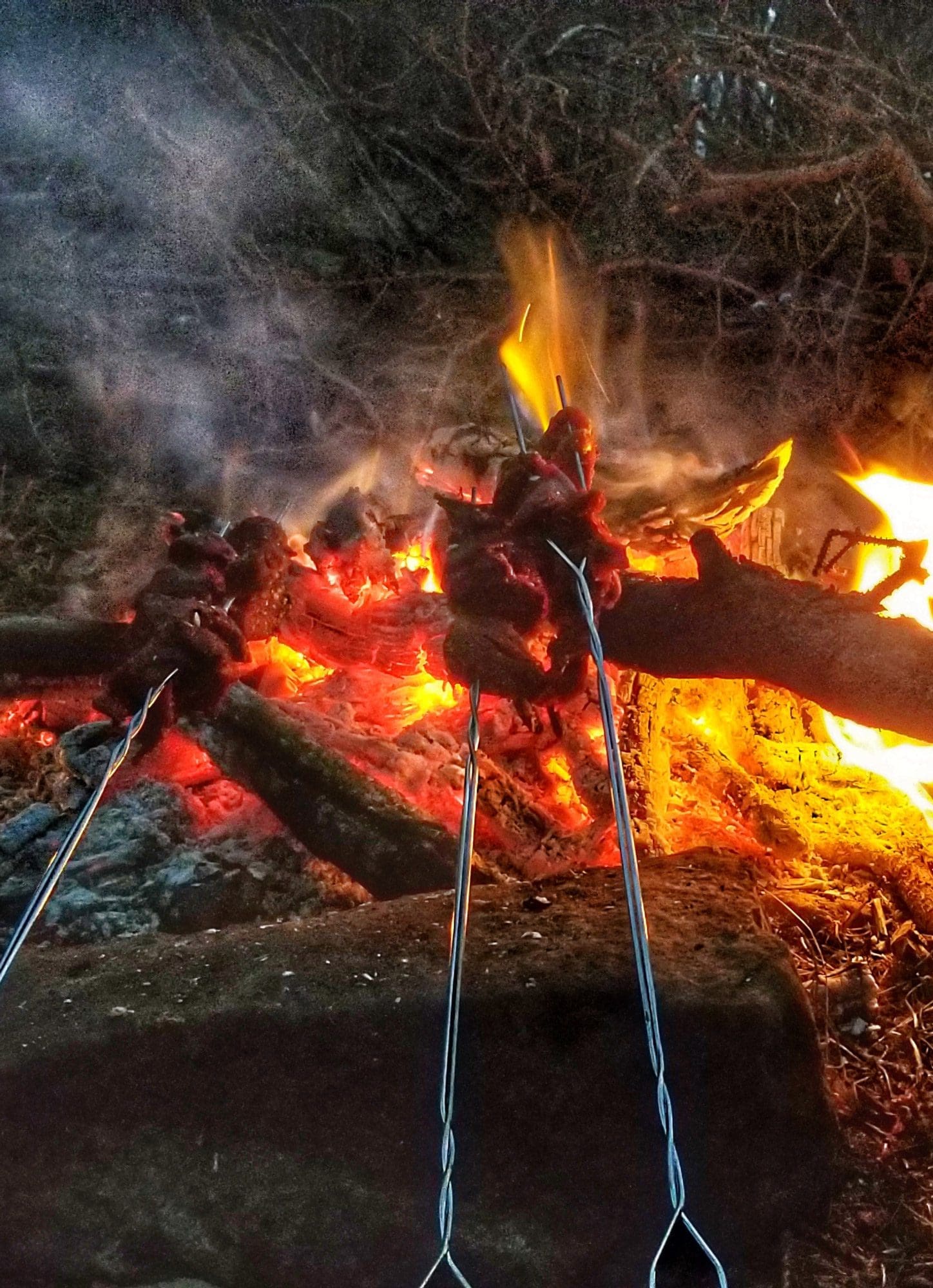
Elk tenderloins, carefully seasoned and cooked over an open fire – accompanied by fried onions, potatoes, and sweet peas – made a wonderful dinner for four hungry hunters.
Personal gear consisted of a mix of Kuiu and Sitka clothing, which we have used many times in the backcountry in all kinds of weather. Horse packing gear was what we always use in the way of Decker saddles, pads, panniers, top packs, etc.
Optics and Tripods:
Optics were an especially important gear element specifically required for the mobile roving camp and long-range spotting techniques used on this hunt. On this hunt, we planned to locate our camps where we could access high points for considerable glassing. This involves very carefully and patiently picking apart distant ridges, aspen thickets, and brushy hillsides up to two miles away in search of a mule deer head, antler, rear end, or whatever. Some days we glassed from daylight until dark.
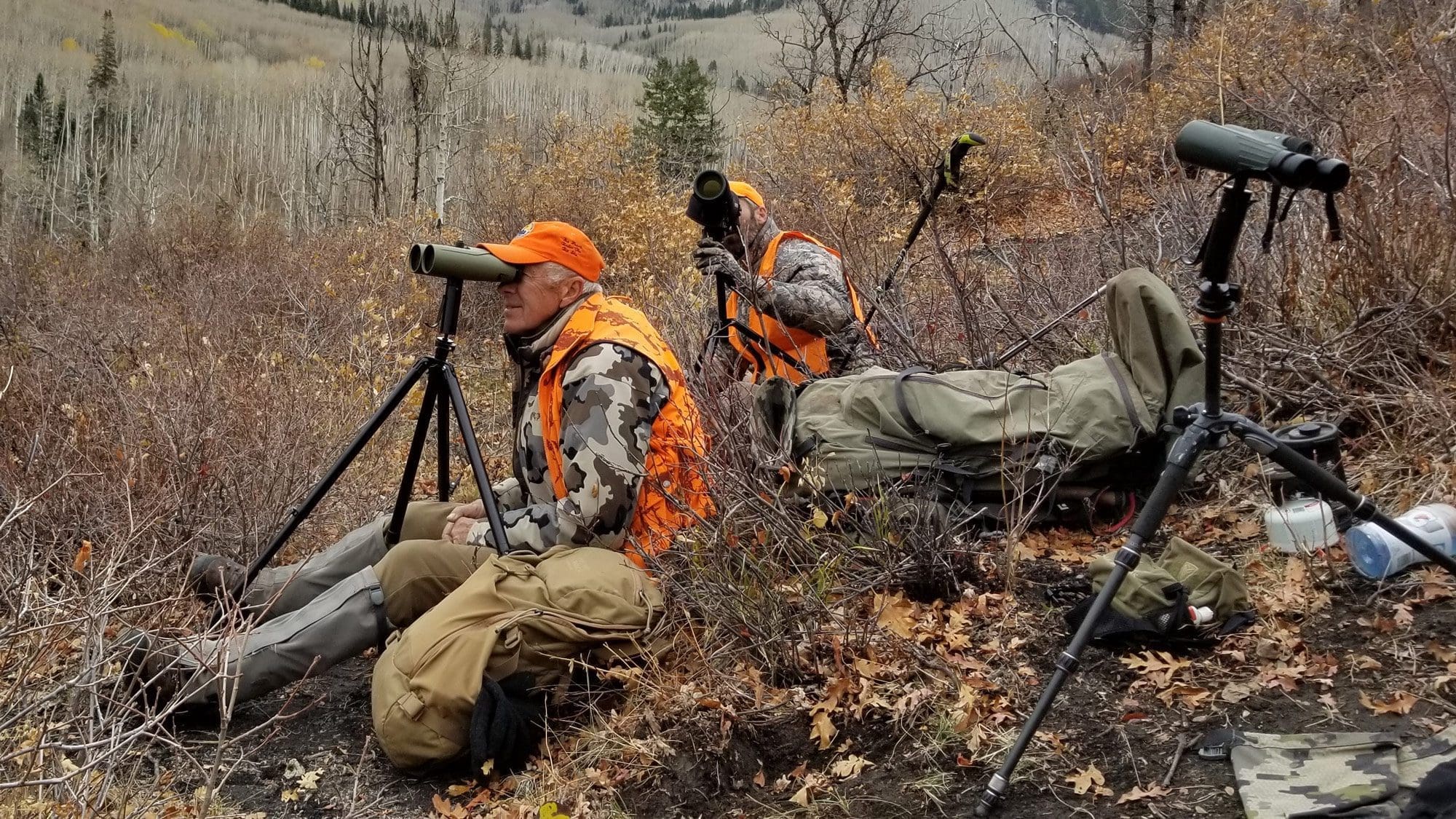
Outdoorsmans tripods are essential for the type of spot-and-stalk techniques the author and his horseback hunting partners used in Colorado. The Outdoorsmans pan head attachment is a must, as you can move your bin- oculars slowly across the landscape with your face as your carefully look at every minute detail in your binocular view. We also used Swarovski binoculars and spotting scopes.
All-day glassing is fatiguing regardless of your gear. Handholding your binoculars without the aid of a tripod is even more difficult. What a lot of hunters don’t know is that the use of a tripod for glassing increases one’s efficiency of spotting game two or threefold, especially at long distances.
We’ve used the Outdoorsmans tripod system for many years and wouldn’t be without them. Floyd Green sold me my first tripod and pistol grip/binocular holder 20 years ago and I’ve used it often without any issues.
For this trip, each of us had his own setup. Todd used a compact medium tripod with the pan head attachment. The “boys” used compact medium tripods and pistol grips with the Outdoorsmans panner attachment. I used a tall tripod with center post extension. I like this tripod because I didn’t do as much climbing as Todd and the boys and I could glass from brushy areas or even from our Camp #4 where I was able to stand while glassing some great habitat.
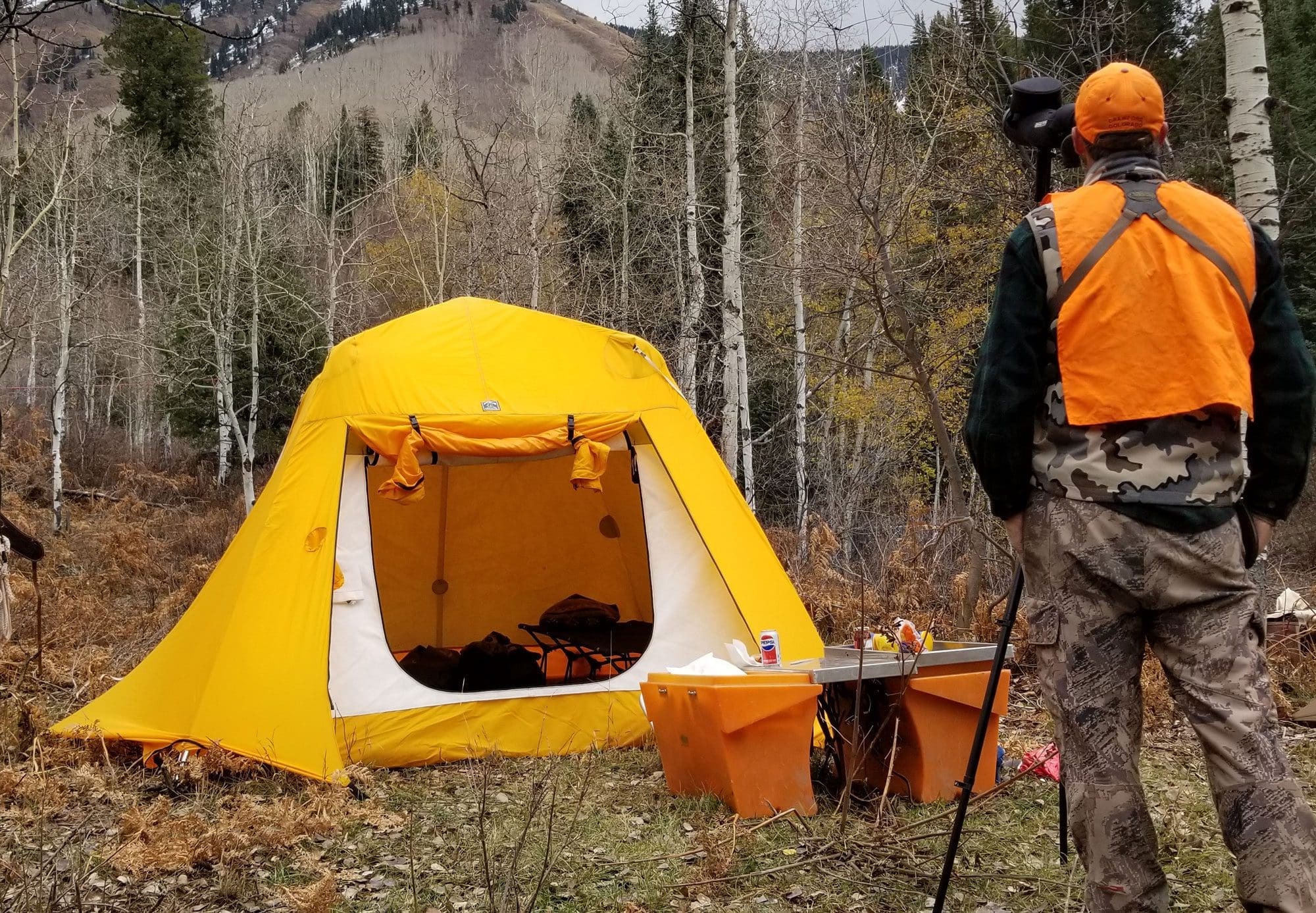
The Outdoorsmans tall tripod with center post extension and pan head attachment enabled us to glass distant mountains from our campsite as well as the glassing point up the ridge from camp.
This turned out to be a great trip with great hunters and friends. The gear we used and the techniques we employed worked especially well and I hope you’ve gained some key mobile camp/roving insights from this article. Perhaps you’ll be able to employ some in your next horseback hunting trip.


